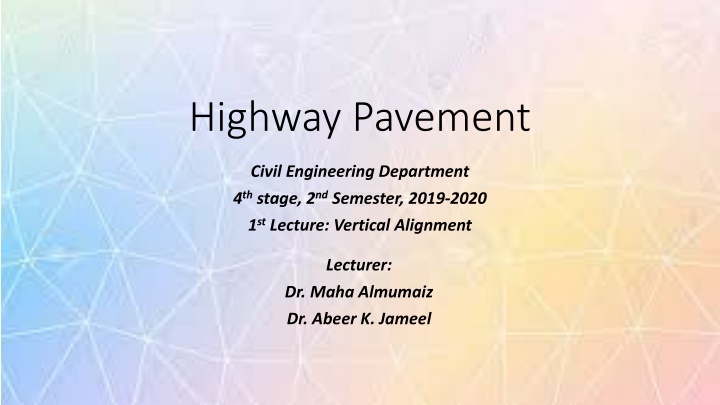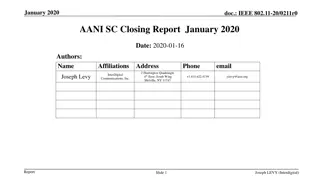
Vertical Alignment in Highway Pavement Design
Explore the principles of vertical alignment in highway pavement design, covering topics such as grade lines, design speed considerations, and drainage control. Learn about critical lengths of upgrade and the need for climbing lanes on rural roads for safe and efficient traffic operations.
Uploaded on | 4 Views
Download Presentation

Please find below an Image/Link to download the presentation.
The content on the website is provided AS IS for your information and personal use only. It may not be sold, licensed, or shared on other websites without obtaining consent from the author. If you encounter any issues during the download, it is possible that the publisher has removed the file from their server.
You are allowed to download the files provided on this website for personal or commercial use, subject to the condition that they are used lawfully. All files are the property of their respective owners.
The content on the website is provided AS IS for your information and personal use only. It may not be sold, licensed, or shared on other websites without obtaining consent from the author.
E N D
Presentation Transcript
Highway Pavement Civil Engineering Department 4thstage, 2ndSemester, 2019-2020 1stLecture: Vertical Alignment Lecturer: Dr. Maha Almumaiz Dr. Abeer K. Jameel
Vertical Alignment N.G.L
cut fill g1 g2 g3 N.G.L
Grade line Max Min Parabolic curve ) = ( Max grade: (for uniform operation of traffic) Depends on: 1. Topography (Terrain) 2. Design speed
Design speed (Km/hr) Topography 60 70 130 80 90 100 110 120 Flat 3% 5% 5% 4% 4% 3% 3% 3% Rolling 4% 6% 6% 5% 5% 4% 4% 4% Mountain 5% 8% 7% 7% 6% 6% 5% 5% - Max design speed 130 km/hr = 5% (max grade)
Min grade: (control of drainage in flat area for curbed road) Inlet 2% Min grade 0.5% for each 100m, rise (fill) = 0.5m 2%
Min grade: (control of drainage in flat area for curbed road) Inlet 2% Min grade 0.5% for each 100m, rise (fill) = 0.5m 2% Inlet 100m 100m 100m 100m Longitudinal profile
2% 2% Rural
2% 2% Rural Critical length of upgrade Max length in the upgrade direction that causes a reduction of 15km/hr in the speed of loaded trucks in comparison with that at the approach. 45km/hr 60km/hr Critical length of upgrade
Grade (%) Critical length of upgrade (m) 3% 420 3 4% 300 100 5% 240 6% 180 420m 7% 150 Climbing lane: additional lane in the direction of upgrade needed where the critical length of upgrade is exceeded.
Climbing lane: needed when the critical length of upgrade is exceeded and is commonly used on two-lane highways for freedom and safety of operations.
Climbing lane: needed when the critical length of upgrade is exceeded and is commonly used on two-lane highways for freedom and safety of operations.
Down grade Emergency Escape Ramp. On long descending grade: Emergency escape ramp suggested to stop out of control vehicle.
Types: + 1. Ascending
Types: + 1. Ascending 2. Level
Types: + 1. Ascending 2. Level 3. Descending -
Parabolic Vertical Curves: Crest Sag
Parabolic Vertical Curves: Crest Sag Types: Symmetrical curve or unsymmetrical
Parabolic Vertical Curves: Crest Sag Types: Symmetrical curve or unsymmetrical Symmetrical
Parabolic Vertical Curves: Crest Sag Types: Symmetrical curve or unsymmetrical Symmetrical Unsymmetrical
















